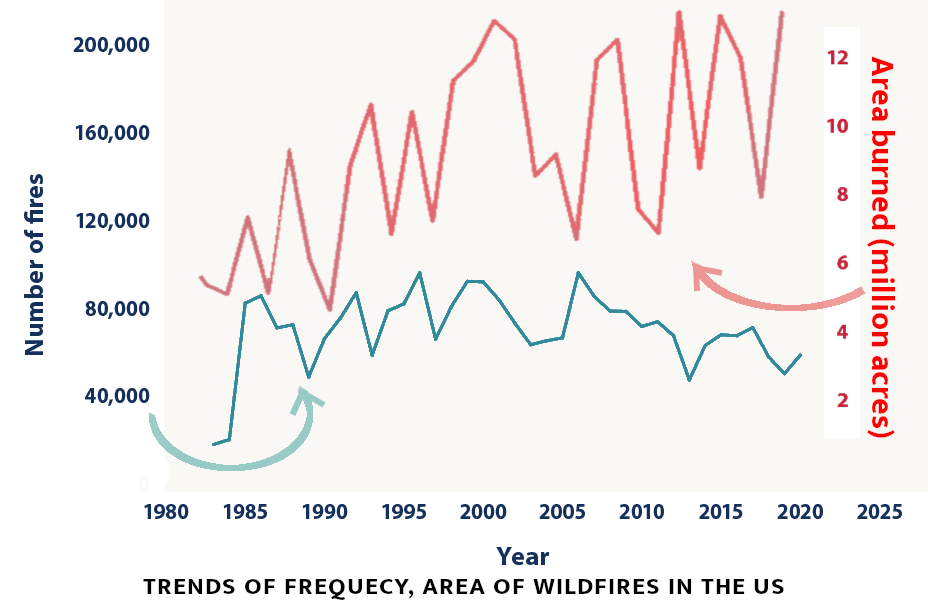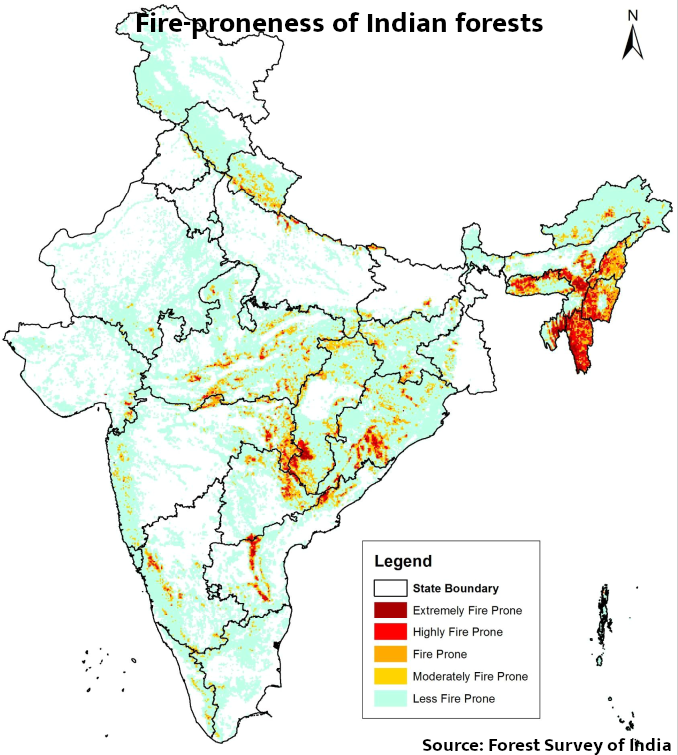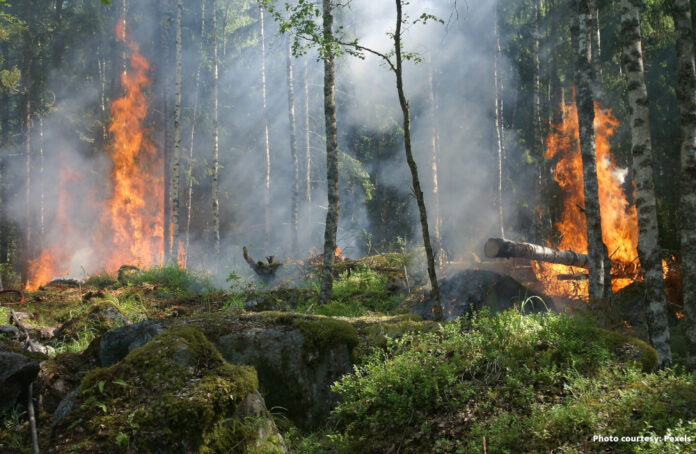Manoj Pandey*
Is Climate Change responsible for rising forest fires, or is it a fallacy?
Some decades back, there used to be very few reports of forest fires in the media. But now reports of fires from all over the world keep appearing, and such instances seem to be turning more ferocious year after year. What alerts us more is the correlation we tend to see between the rise in global temperatures – and consequent climate change – and forest fires.
To be sure, let us check the facts.
How do forest fires originate?
When natural vegetation is caught by uncontrolled fire, it is called wildfire. Since forests happen to be the thickest form of natural habitats, most wildfires engulf forests, and so are called forest fires. In that sense, I am using the terms almost synonymously.
Forest fires are as old as forests themselves. So, the first forest fire must have happened over 400 million years ago.
Lightning is one major natural cause of forest fires. By its very nature, lightning picks up tall, conical trees more than others for falling on the ground. The voltage of the falling current is so high that it instantly causes sparks and fire.
The other natural cause is volcanic eruption. Though it happens only in certain parts of the world, it does cause major fires in those areas.
In some parts of the world, underground fires rage for a very long time. A well-known example is smouldering of underground coal. That can dry up surface vegetation, whether grasslands or forests, and burn them.
When fire starts in a thick vegetation (mostly natural forests), it is immediately picked up by dry leaves. Depending on the type of vegetation and other factors, it spreads through surface litter and dead trees or crown or simmers under the surface.
What turns a small fire in the forest into a wildfire is the abundance of inflammable matter and factors that feed the fire. How strong the fire would be and how long it would last depend on many natural factors such as the type of forest/ grassland, physical setting of the land, availability of dry and wet burning material, wind behaviour and other weather conditions. In Australia, even birds of some kinds are known to spread forest fires by transporting smouldering pieces of wood (along with preys caught in fire) to distant areas.
In summers, inflammable dry mass is available in abundance, causing the fire to turn big and spread fast. Once it gains a critical mass, the fire progresses by first drying the wet and live matter in its surroundings, and then using that very dried matter for spreading itself. Fire in hills helps its own spread by creating hot air streams that dry up jungles uphill.
Humans contribute to forest fires by many indirect and direct ways. Indirect human activities include change in land use and forest type, fire-conducive activities near forests, poor forest management practices, and drying of forests due to exploitation. Direct human actions that cause forest fires include fire used for forest clearing operations which can go out of hand, negligent use of fire in forests (e.g by travellers and campers), stubble burning in farms adjacent to forests, and deliberate torching of forests with a criminal intent.
How do forest fires harm humans and the environment?
In some types of forests, forest fires help in maintaining a healthy ecosystem by recycling nutrients into the soil, helping in seed dispersal and clearing ground for fresh vegetation. Such fires do not destroy all vegetation in the forest, and they displace the wildlife rather than killing them in a large scale. However, most wildfires are of a highly destructive kind.
Forest fires impact humans, other living beings and the earth’s atmosphere in many ways. They create local weather changes and pollute the air. Intense forest fires create a massive upward draft of gases and thus distribute the emissions far and wide. The emission caused by wildfires impacts human health.
In many parts of the world, forest fires reach human habitations and result in loss of property and farms, urban forest cover, and crops.
In addition, forest fires hurt the environment in a number of ways. They pollute water and can also dry up underground water recharging. Forest fires damage the green cover, destroy biodiversity and disturb the ecosystem.
One profound and long-lasting impact of forest fires is emission of a huge quantity of carbon di oxide and other carbonic gases into the atmosphere. In recent years, forest fires are supposed to have caused more than a fifth of the total global carbon emission.
Have forest fires increased in numbers and ferocity in recent years?
Yes and no. Look at the graphic below. In this, I have juxtaposed US data on frequency of wildfires with the intensity of such fires for the last 40 years. While the number of forest fires has remained more or less the same, the area burned by such fires has marginally risen over the years.

That was a broad snapshot. When we look at details, it gets a bit mixed-up. The intensity and period of fires in a year keep varying from State to State – and so, in years of high overall damage due to wildfires, some States had low fire damage. A subtle trend is, however, seen in that recent years have seem more number of warm days, and the peak of forest fire season has advanced to July from August.
A Canadian study of eight decades (1920-2000) has found a slow drop in the area under forest fires in the first forty years, but a gradual rise in the succeeding decades.
Globally, parts of Siberia, Australia and California region of the US see frequent wildfires, sometimes turning very severe and lasting for months. Forest fires were rare in tropical humid forests earlier, but of late, these have become common. The same is happening in grasslands (Savannah) in tropical and higher latitudes. In California, 13 out of 20 worst wildfires are reported in the last five years. Major fire events have also taken place in recent years in Canada, the Mediterranean, Amazon forests, and Indonesia.
In India, a trend of rising forest fire incidents has been documented.
After studying the prevalence of forest fires in the past 13 years, the Forest Survey of India in 2019 came out with detailed data on the vulnerability of Indian forests to fires. More than 36% of the country’s forest cover is categorised as ‘prone to frequent fires’, out of which, approximately 10% is ‘extremely to very highly prone’ to fires. Over 30,000 forest fire incidents are reported in a year. It is estimated that 2-5 % of forests are affected by fires every year.

Forest of the North East are highly fire-prone, mostly due to jhum (or slash-and-burn) cultivation. Forests in the middle parts of India are second in fire proneness, largely due to a long dry season and also criminal activities. In some parts of Uttarakhand and adjoining Nepal, forest fires are an annual occurrence. In most such places, pine is the main forest tree, and its fallen leaves (called needles) make a bed on the forest floor, which is highly inflammable. Steep slopes and dry weather for many months add the proverbial fuel to the fire.
Is climate change responsible for recent big forest fires?
Let’s examine this closely with the help of available facts.
Though some forest fires reported in the recent years have been exceptionally severe, each of them cannot be directly attributed to climate change. But, yes, it is fairly well-documented that now human activities of all kinds are responsible for forest fires more than natural causes.
Instead of blaming climate change for forest fires, the situation would be better represented like this: humans are responsible for a lot of environmental destruction, one of whose consequences is the climate change. Increase in forest fires is a symptom of this destruction.
Interestingly, in India, forest fires are not classified as a natural disaster by the National Disaster Management Authority, as most forest fires are supposed to occur due to direct human actions!
Memories of a forest butchered and burnt alive
While I’m writing this piece, my memories of long-gone childhood are rekindled – memories of a thick pine forest that covered the slopes above my tiny village perched on a Himalayan ridge.
It was 50-55 years ago. I was too young to know the profoundness of what was happening around my village, and there was hardly any environmental consciousness in those villages. Partly, it might have been because there was plenty of tree-cover within and around the village.
One day, while climbing the slope to our school three miles away, we boys found some strangers sawing a huge pine tree. With their long saws, they could fell a tree before we even passed a small ridge. (With their axes, our parents would take half a day to fell even a mid-sized tree.) The view of a massive tree rolling down and carrying with it a handful of smaller trees, and causing a resounding roar, was thrilling. On return, we found the entire ridge naked of tall trees. Within days, ridge after ridge got denuded. It looked good from a child’s point of view: there was now less risk of encountering a wild animal on way to school or on the grazing slopes, there were plenty of fallen pine cones full of pine nut, and one could collect a lot of fuel-wood – tree limbs and twigs discarded by the contractor.
In the ensuing summer, there was a massive fire in the forest. Fires used to be routine in these pine forests, usually caused by forest officials in a controlled manner. So, nobody took notice. Then one evening, we saw fires in all the ridges that had seen felling of trees. These fires were uncontrollable. After the main fire extinguished, the forests kept on smouldering for days, and when our school opened after summer holidays, we had burning pine roots and smoke for company.
For years together, we children had no fear of a bear or leopard on our way to school and back; we had learnt that animals feared open areas and fire.
It was only a decade later that I came to know that the felling of trees in ‘government forests’ was carried out in a way that each marked tree broke many more trees, and these ‘accidentally broken’ trees were the contractor’s bonus. The fire, knowledgeable people said, were deliberate, to hide not only the massive loot that had been carried out during contracted tree-felling but also separately by forest officials. It was also common knowledge that the local forester was getting fire-fighting budget in the following years for the ground-clearing that he didn’t have to do.
Most of the village has migrated to the plains. Some of us are not able to visit the village for years even for a traditional puja, but the few that still live there tell that the forest fire visits the surrounding forests with a sinister regularity.
Forest fires are not just a symptom. A cause-effect vicious cycle runs between forest fires and climate change. Forest fires cause pollution and directly raise temperature, thus contributing to climate change. At the same time, climate change induces droughts, longer dry seasons, and more incidences of lightning and storms. These contribute to occurrence and intensity of forest fires. No wonder, forest fires have been described by the UN Environment Programme as one of the most impactful environmental issues related to climate change.
A UNEP report says, forest fires are likely to rise by 14% by the end of this decade, and 33% in the next 3 decades, even if the world manages to keep greenhouse gas emissions at a moderate level.
Experts have made predictive models about climate change, and they predict that in the coming decade, the forest fire-prone areas will see more fire events while other areas will also start having major fire events.
To cut the story short, climate change and forest fires are fuelling each other, and there is no doubt about that. However, on seeing a news report on a major wildfire, we should not jump to the conclusion that this particular event is the direct result of climate change.
Further reading
- Climate Change Indicators: Wildfires
- Identification of Fire Prone Forest Areas Based on GIS Analysis of Archived Forest Fire Points Detected in the Last Thirteen Years
- India’s forest fires are getting bigger and hotter, like the rest of the world
- Spreading Like Wildfire
******

*Manoj Pandey is a former civil servant. He does not like to call himself a rationalist, but insists on scrutiny of apparent myths as well as what are supposed to be immutable scientific facts. He maintains a personal blog, Th_ink
Disclaimer: The views expressed in this article are the personal opinion of the author and do not reflect the views of raagdelhi.com which does not assume any responsibility for the same.



